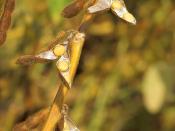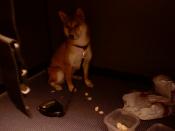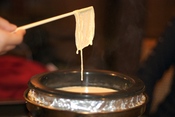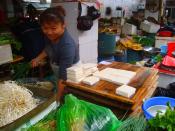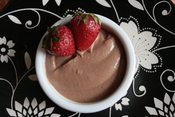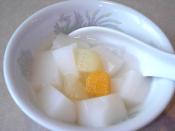Tofu is made from the curd of soybeans. The exact history of soybeans is not entirely known, soybeans were being cultivated, at least in east China, by about 1100 B.C. It soon became a main choice in the Chinese diet and, as many cultures do, the Chinese showed respect for this wondrous food by giving it the name ta tou, meaning the "greater bean." The bean curd from this "great bean," is what is known as tofu. Tofu was used a great deal in traditional medicine. The "greater bean" curd was used to aid everything from ulcers to the common cold. Tofu was introduced in Japan, in the Nara period (761-793). At first tofu was called okara, the old cookbooks referred to it as "kabe" (wall) or "shirakabe" (white wall). It was first called tofu in the Muromachi period (1392-1573). In the Edo period (1603-1867), tofu became popular among the public.
Tofu is still used today by a growing number of people, who have found it beneficial in their diets. We can get ÃÂü of one day's required nutrition from a block of tofu. It contains 6.8g., of vegetable protein, very little cholesterol, neutral fat, and a very little sodium. Tofu is very good for those people who are suffering from high blood pressure. Tofu is one of today's best source of calcium. There are two main kinds of tofu out in the market. There is Momen-tofu which contains most of the calcium, rather than the second kind of tofu, Kinu-tofu. The process of making tofu begins with the soybeans being harvested, machine crushed, and then soaked in water for one night. Then, the soybeans are boiled. After that, the boiled soybeans are filtered through a cloth. The liquid is what we know as soymilk. The remaining beans are known as okara. Momen means cotton. Momen-tofu is made by mixing the soy milk and a coagulant, into a container that is covered with a cotton cloth. When the mixture solidifies, a weigth is placed on top of it so that excess water seeps through the rough cotton cloth, and removed. Kinu means silk. Kinu-tofu is made the way similar to the Momen-tofu, only no cloth is placed on top, not even a silk one. The end result is called Kinugosi, because it feels like silk, and has a very smooth taste.
Mounting the large amount of evidence from the years of research, today is verifying many of tofu's traditional characteristics, along with a few new ones.
